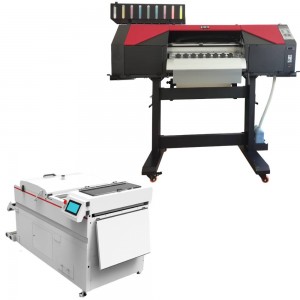What things will affect the quality of DTF Transfer Patterns?
1.Print head-one of the most essential components
Do you know why inkjet printers can print a variety of colors? The key is that the four CMYK inks can be mixed to produce a variety of colors, the printhead is the most essential component in any printing job, which type of printhead is used greatly affects the overall outcome of the project, so the status of the print head is very important to the quality of the printing effect. The printhead is made with a lot of tiny electrical components and multiple nozzles that will hold the different ink colors, it will spray or drop the inks onto the paper or film that you put in the printer.
For example, the Epson L1800 print head has 6 rows of nozzle holes, 90 in each row, a total of 540 nozzle holes. In general, the more nozzle holes in the print head, the faster the printing speed, and the printing effect will be more exquisite too.
But if some of the nozzle holes are clogged, the printing effect will be defective. Because the ink is corrosive, and the inside of the print head is composed of plastic and rubber, with the increase in use time, the nozzle holes may also be clogged by ink, and the surface of the print head may also be contaminated with ink and dust. The lifespan of a print head may be around 6-12 months, so the print head needs to be replaced in time if you find the test strip is incomplete.
You can print the test strip of the print head in the software to check the status of the print head. If the lines are continuous and complete and the colors are accurate, indicates that the nozzle is in good condition. If many lines are intermittent, then the print head needs to be replaced.
2.Software settings and printing curve (ICC profile)
In addition to the influence of the print head, the settings in the software and the selection of the printing curve will also affect the printing effect. Before starting to print, choose the right scale unit in the software that you need, such as cm mm and inch, and then set the ink dot to medium. The last thing is to select the printing curve. To achieve the best output from the printer, all parameters need to be set correctly. As we know that various colors are mixed from four CMYK inks, so different curves or ICC Profiles correspond to different mixing ratios. The printing effect will also vary depending on the ICC profile or the printing curve. Of course, the curve is also related to the ink, this will be explained below.
During printing, the individual drops of ink that are put onto the substrate will affect the overall quality of the image. Smaller drops will produce a better definition and higher resolution. This is primarily better when creating easy-to-read text, especially text that may have fine lines.
The use of larger drops is better when you need to print quickly by covering a large area. Large drops are better for printing larger flat pieces such as large format signage.
The printing curve is built into our printer software, and the curve is calibrated by our technical engineers according to our inks, and the color accuracy is perfect, so we recommend using our ink for your printing. Other RIP software also requires you to import the ICC profile to print. This process is cumbersome and unfriendly to newbies.
3.Your Image format and pixel size
The printed pattern is also related to your original image. If your image has been compressed or the pixels are low, the output result will be poor. Because the printing software cannot optimize the picture if it is not very clear. So the higher the resolution of the image, the better the output result. And the PNG format picture is more suitable for printing as it doesn’t white background, but other formats are not, such as JPG, it will be very strange if you print white background for a DTF design.
4.DTF Ink
Different inks have different printing effects. For example, UV inks are used to print on various materials, and DTF inks are used to print on transfer films. Printing Curves and ICC profiles are created based on extensive testing and adjustments, if you choose our ink, you can directly select the corresponding curve from the software without setting the ICC profile, which saves a lot of time, And our inks and curves are well matched, the printed color is also the most accurate, so it is highly recommended that you choose our DTF ink to use.If you choose other DTF inks, the printing curve in the software may not accurate for the ink, which will also affect the printed result. Please remember that you must not mix different inks to use, it is easy to block the print head, and the ink also has a shelf life, Once the ink bottle is opened, it is recommended to use it up within three months, otherwise, the activity of the ink will affect the print quality, and the probability of clogging the print head will increase. Complete sealed ink has a shelf life of 6 months, it is not recommended to use if the ink has been stored for more than 6 months
5.DTF transfer film
There is a large variety of different film circulating the DTF market. Generally speaking, more opaque film resulted in better results because it tends to have more ink absorbing coating. But some films has loose powder coating which resulted in uneven prints and some areas just refused to take in ink. Handling such film was difficult with powder constantly being shaken off and fingertips leaving fingerprint marks all over the film.
Some films started off perfectly but then warped and bubbled during curing process. This one type of DTF film in particular seemed to have melting temperature below that of a DTF powder. We ended up melting the film before the powder and that was at 150C. Maybe it was designed for lower melting point powder? Bu then surely that would affect wash-ability at high temperatures. This other type of film warped so much, it lifted itself up 10cm and stuck to the top of the oven, setting itself on fire and ruining the heating elements.
Our transfer film is made of high-quality polyethylene material, with a thick texture and a special frosted powder coating on it, which can make the ink stick to it and fix it. The thickness ensures the smoothness and stability of the printing pattern and ensures the transfer effect
6.Curing oven and adhesive powder
After adhesive powder coating on the printed films, the next step is to place it in a specially designed curing oven. The oven needs to heat the temperature to 110°at least, if the temperature is below 110°, The powder cannot be completely melted, resulting in the pattern not being firmly attached to the substrate, and it is easy to crack after a long time. Once the oven has reached the set temperature, it needs to keep heating the air for 3 minutes at least. So the oven is very important because it will affect the paste effect of the pattern, a substandard oven is a nightmare for DTF transfer.
The adhesive powder also affects the quality of the transferred pattern, it is less viscous if the adhesive powder with a lower quality grade. After the transfer is completed, the pattern will easily foam and crack, and the durability is very poor. Please choose our high-grade hot melt adhesive powder to ensure quality if possible.
7.The heat press machine and T-shirt quality
Except for the above major factors, the operation and settings of the heat press are also critical for pattern transfer. First of all, the temperature of the heat press machine must reach 160° in order to completely transfer the pattern from the film onto the T-shirt. If this temperature cannot be reached or the time of the heat press is not enough, the pattern may be peeled off incompletely or cannot be transferred successfully.
The quality and flatness of the T-shirt will also affect the transfer quality. In the DTG process, the higher the cotton content of the T-shirt, the better the printing effect. Although there is no such limitation in the DTF process, the higher the cotton content, the stronger the sticking of the transfer pattern. And the T-shirt should be in a flat state before the transfer, so we strongly recommend that the T-shirt be ironed in a heat press before the transfer process starts, it can keep the T-shirt surface completely flat and no moisture inside, which will ensure the best transfer results.
Post time: Oct-13-2022






